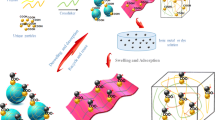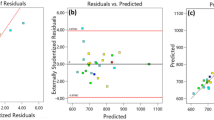Abstract
A cross-linked copolymer (XL-P(AA-co-VAc)) of vinyl acetate and acrylic acid was prepared using azobisisobutyronitrile as initiator and N,N’-methylenebisacrylamide as crosslinker. Then, XL-P(AA-co-VAc) was reacted with ethanol to prepare a crosslinked carboxyl modified polyvinyl alcohol (XL-P(AA-co-VA)). The as-prepared XL-P(AA-CO-VA) hydrogel was characterized by FTIR, XRD, SEM and BET, and investigated as an selective heavy metal ion adsorbent. The adsorption characteristics of the XL-P(AA-CO-VA) hydrogel were studied with a aqueous solution containing ternary metal ions Cu(II), Cd(II) and Ni(II). It was found that XL-P(AA-CO-VA) can selectively adsorb Cu(II) in competition with Cd(II) and Ni(II), and the selectivity coefficients of 48 (βCu(II)/Cd(II)) and 80 (βCu(II)/Ni(II)) were obtained. The kinetics were demonstrated to match well with the pseudo-second order kinetics model with the rate constants (K2, g/(mg•min)) of 3.71✕10− 4, 0.0011 and 0.0015 for Cu(II), Cd(II) and Ni(II), respectively. The equilibrium adsorption of Cu(II) to the XL-P(AA-CO-VA) hydrogel follows the Langmuir adsorption model with qmax of 41.27 mg/g and KL of 0.94 L/mg. The thermodynamic studies indicate that ΔG0 was negative and increased with temperature, and the adsorption process of XL-P(AA-CO-VA) for Cu(II) ion was spontaneous and exothermic. ΔH and ΔS were − 56.57 kJ/mol and − 171.18 J·(mol·K)−1, respectively. The XL-P(AA-CO-VA) hydrogel is of interest for the selective separation of Cu(II) from industrial wastewater containing Cd(II) and Ni(II).










Similar content being viewed by others
References
Gong Y, Zhao D, Wang Q (2018) An overview of field-scale studies on remediation of soil contaminated with heavy metals and metalloids: Technical progress over the last decade. Water Res 147:440–460
Lofrano G, Carotenuto M, Libralato G, Domingos RF, Markus A, Dini L, Gautam RK, Baldantoni D, Rossi M, Sharma SK, Chattopadhyaya MC, Giugni M, Meric S (2016) Polymer functionalized nanocomposites for metals removal from water and wastewater: An overview. Water Res 92:22–37
Balladares E, Jerez O, Parada F, Baltierra L, Hernández C, Araneda E, Parra V (2018) Neutralization and co-precipitation of heavy metals by lime addition to effluent from acid plant in a copper smelter. Miner Eng 122:122–129
Ge Y, Li Z (2018) Application of Lignin and Its Derivatives in Adsorption of Heavy Metal Ions in Water: A Review. ACS Sustain Chem Eng 6(5):7181–7192
Gámez S, Garcés K, de la Torre E, Guevara A (2019) Precious metals recovery from waste printed circuit boards using thiosulfate leaching and ion exchange resin. Hydrometallurgy 186:1–11
Abdullah N, Yusof N, Lau WJ, Jaafar J, Ismail AF (2019) Recent trends of heavy metal removal from water/wastewater by membrane technologies. J Ind Eng Chem 76:17–38
Leyma R, Platzer S, Jirsa F, Kandioller W, Krachler R, Keppler BK (2016) Novel thiosalicylate-based ionic liquids for heavy metal extractions. J Hazard Mater 314:164–171
Zeng L, Liu Q, Luo L, Liu L, Tang K (2019) Enhancement mechanism of an improved liquid membrane using selective permeation retardant for heavy metal ions separation. Chem Eng Sci 201:1–14
Huang J, Huang Z-L, Zhou J-X, Li C-Z, Yang Z-H, Ruan M, Li H, Zhang X, Wu Z-J, Qin X-L, Hu J-H, Zhou K (2019) Enhancement of heavy metals removal by microbial flocculant produced by Paenibacillus polymyxa combined with an insufficient hydroxide precipitation. Chem Eng J 374:880–894
Zhao G, Huang X, Tang Z, Huang Q, Niu F, Wang X (2018) Polymer-based nanocomposites for heavy metal ions removal from aqueous solution: a review. Polym Chem-UK 9(26):3562–3582
Sajid M, Nazal MK, Ihsanullah, Baig N, Osman AM (2018) Removal of heavy metals and organic pollutants from water using dendritic polymers based adsorbents: A critical review. Sep Purif Technol 191:400–423
Lin S, Wei W, Wu X, Zhou T, Mao J, Yun Y-S (2015) Selective recovery of Pd(II) from extremely acidic solution using ion-imprinted chitosan fiber: Adsorption performance and mechanisms. J Hazard Mater 299:10–17
Liu J, Su D, Yao J, Huang Y, Shao Z, Chen X (2017) Soy protein-based polyethylenimine hydrogel and its high selectivity for copper ion removal in wastewater treatment. J Mater Chem A 5(8):4163–4171
Gao B, Gao Y, Li Y (2010) Preparation and chelation adsorption property of composite chelating material poly(amidoxime)/SiO2 towards heavy metal ions. Chem Eng J 158(3):542–549
Peng W, Li H, Liu Y, Song S (2017) A review on heavy metal ions adsorption from water by graphene oxide and its composites. J Mol Liq 230:496–504
Li X, Wang Z, Li Q, Ma J, Zhu M (2015) Preparation, characterization, and application of mesoporous silica-grafted graphene oxide for highly selective lead adsorption. Chem Eng J 273:630–637
Da’na E (2017) Adsorption of heavy metals on functionalized-mesoporous silica: A review. Micropor Mesopor Mat 247:145–157
Ray PZ, Shipley HJ (2015) Inorganic nano-adsorbents for the removal of heavy metals and arsenic: a review. RSC Adv 5(38):29885–29907
Ahmad M, Manzoor K, Ikram S (2017) Versatile nature of hetero-chitosan based derivatives as biodegradable adsorbent for heavy metal ions; a review. Int J Biol Macromol 105:190–203
Kausar A, MacKinnon G, Alharthi A, Hargreaves J, Bhatti HN, Iqbal M (2018) A green approach for the removal of Sr(II) from aqueous media: Kinetics, isotherms and thermodynamic studies. J Mol Liq 257:164–172
Naeem H, Bhatti HN, Sadaf S, Iqbal M (2017) Uranium remediation using modified Vigna radiata waste biomass. Appl Radiat Isotopes 123:94–101
Rashid A, Bhatti HN, Iqbal M, Noreen S (2016) Fungal biomass composite with bentonite efficiency for nickel and zinc adsorption: A mechanistic study. Ecol Eng 91:459–471
Kausar A, Bhatti HN, MacKinnon G (2016) Re-use of agricultural wastes for the removal and recovery of Zr(IV) from aqueous solutions. J Taiwan Inst Chem E 59:330–340
Karim MR, Aijaz MO, Alharth NH, Alharbi HF, Al-Mubaddel FS, Awual MR (2019) Composite nanofibers membranes of poly(vinyl alcohol)/chitosan for selective lead(II) and cadmium(II) ions removal from wastewater. Ecotox Environ Safe 169:479–486
Mallakpour S, Motirasoul F (2019) Cross-linked poly(vinyl alcohol)/modified α-manganese dioxide composite as an innovative adsorbent for lead(II) ions. J Clean Prod 224:592–602
Karpagam S, Guhanathan S (2013) Flame-retardant and morphological analysis of nitrogen heterocycle-modified poly(vinyl alcohol) and their application for adsorption of heavy metal ions. J Appl Polym Sci 129(4):2046–2056
Mahmoodi NM, Mokhtari-Shourijeh Z (2016) Modified poly(vinyl alcohol)-triethylenetetramine nanofiber by glutaraldehyde: preparation and dye removal ability from wastewater. Desalin Water Treat 57(42):20076–20083
Zheng Y, Wang YJ, Chen X, Qing L, Yang H (2007) Preparation and Characterization of Poly(vinyl alcohol)/Hydroxylapatite Hybrid Hydrogels. J Compos Mater 41(17):2071–2082
Guedidi H, Reinert L, Lévêque J-M, Soneda Y, Bellakhal N, Duclaux L (2013) The effects of the surface oxidation of activated carbon, the solution pH and the temperature on adsorption of ibuprofen. Carbon 54:432–443
Aksu Z (2001) Equilibrium and kinetic modelling of cadmium(II) biosorption by C. vulgaris in a batch system: effect of temperature. Sep Purif Technol 21(3):285–294
Gao Z, Bandosz TJ, Zhao Z, Han M, Qiu J (2009) Investigation of factors affecting adsorption of transition metals on oxidized carbon nanotubes. J Hazard Mater 167(1):357–365
Wu S, Wang F, Yuan H, Zhang L, Mao S, Liu X, Alharbi NS, Rohani S, Lu J (2018) Fabrication of xanthate-modified chitosan/poly(N-isopropylacrylamide) composite hydrogel for the selective adsorption of Cu(II), Pb(II) and Ni(II) metal ions. Chem Eng Res Des 139:197–210
Li Y-H, Ding J, Luan Z, Di Z, Zhu Y, Xu C, Wu D, Wei B (2003) Competitive adsorption of Pb2+, Cu2+ and Cd2+ ions from aqueous solutions by multiwalled carbon nanotubes. Carbon 41(14):2787–2792
Trivedi P, Axe L, Dyer J (2001) Adsorption of metal ions onto goethite: single-adsorbate and competitive systems. Colloid Surface A 191(1):107–121
Tan P, Hu Y, Bi Q (2016) Competitive adsorption of Cu2+, Cd2+ and Ni2+ from an aqueous solution on graphene oxide membranes. Colloid Surface A 509:56–64
Zeng L, Liu Q, Lu M, Liang E, Wang G, Xu W (2019) Modified natural loofah sponge as an effective heavy metal ion adsorbent: Amidoxime functionalized poly(acrylonitrile-g-loofah). Chem Eng Res Des 150:26–32
Zeng L, Liu Q, Xu W, Wang G, Xu Y, Liang E (2020) Graft Copolymerization of Crosslinked Polyvinyl Alcohol with Acrylonitrile and Its Amidoxime Modification as a Heavy Metal Ion Adsorbent. J Polym Environ 28(1):116–122
Al-Ghouti M, Khraisheh MAM, Ahmad MNM, Allen S (2005) Thermodynamic behaviour and the effect of temperature on the removal of dyes from aqueous solution using modified diatomite: A kinetic study. J Colloid Interf Sci 287(1):6–13
Acknowledgements
We thank the National Natural Science Foundation of China (No. 51674117, 21706059), the Provincial Natural Science Foundation of China’s Hunan Province (No. 2020JJ4332, 2018JJ3206), Scientific Research Fund of Hunan Provincial Education Department (No. 18B354, 16K036, 15B101), and the Innovation and Entrepreneurship Training Program for College Students in Hunan Province of China (No. S201910543032). Thanks to the Key Laboratory of Hunan Province for Advanced Carbon-based Functional Materials, School of Chemistry and Chemical Engineering, Hunan Institute of Science and Technology, Yueyang, 414006, China. Hunan Province (Xiangcai Construction (2019) 0011).
Author information
Authors and Affiliations
Corresponding authors
Additional information
Publisher's Note
Springer Nature remains neutral with regard to jurisdictional claims in published maps and institutional affiliations.
Rights and permissions
About this article
Cite this article
Zeng, L., Zhou, F., Hu, R. et al. Synthesis of Cross-linked Carboxyl Modified Polyvinyl Alcohol and its Application in Selective Adsorption Separation of Cu(II) from Cd(II) and Ni(II). J Polym Environ 29, 28–37 (2021). https://doi.org/10.1007/s10924-020-01847-z
Published:
Issue Date:
DOI: https://doi.org/10.1007/s10924-020-01847-z




